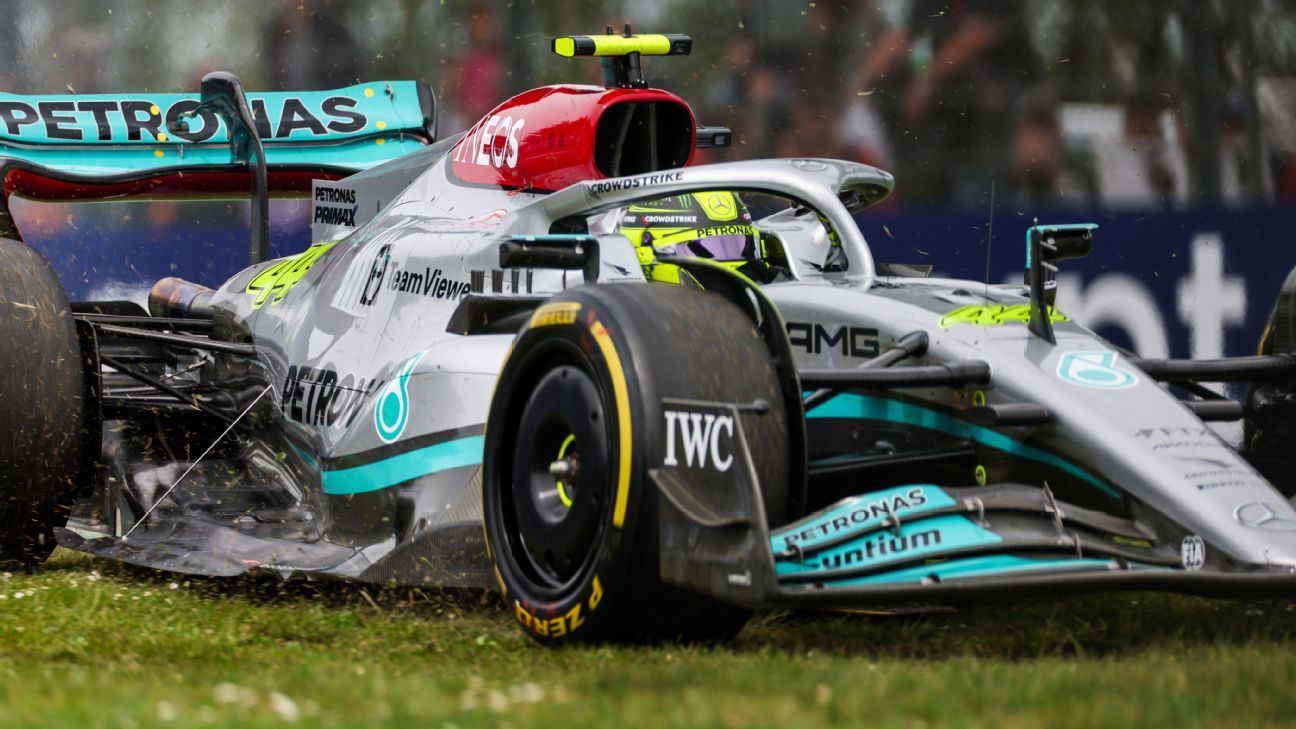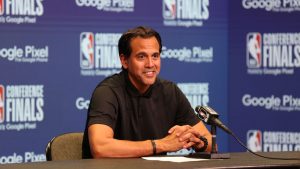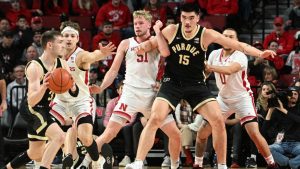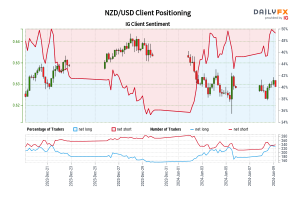Why was Lewis Hamilton so bad at Imola? ist die Überschrift der Nachrichten, die der Autor von NachrichtenStar diesen Artikel gesammelt hat. Bleiben Sie auf NachrichtenStar auf dem Laufenden, um die neuesten Nachrichten zu diesem Thema zu erhalten. Wir bitten Sie, uns in sozialen Netzwerken zu folgen.
As Lewis Hamilton crossed the line in 13th place at the Emilia Romagna Grand Prix, Mercedes team principal Toto Wolff issued an apology to his driver over the pit-to-car radio.
„Lewis, sorry for what you have needed to drive today,“ Wolff said. „This is undriveable and not what we deserve to score as a result. We will move on from there, but this was a terrible race.“
The implication was that Hamilton was not to blame for the lowly finishing position, which included the indignity of being lapped by race winner Max Verstappen, whom Hamilton fought for the title in 2021.
Given that Hamilton is a seven-time world champion, it’s easy to see where Wolff was coming from, but the sentiment seemed to jar with the performance of Hamilton’s teammate George Russell, who finished fourth in the same car. On paper the result looked awful for Hamilton and means he is now 21 points adrift of his younger teammate after finishing behind him at three consecutive races.
But dig deeper into Mercedes‘ problems and how they impacted Hamilton’s weekend, and it’s easier to understand why Wolff issued such a public apology to Hamilton despite Russell’s strong performance in the sister car. Working back through the Imola race weekends of Hamilton and Russell, it’s easy to see how their diverging fortunes were not a fair reflection of the gap in performance between the two.
Of course, that should take nothing away from Russell’s performance in Imola, which was undoubtedly better than Hamilton’s, but it’s unfair to assume Hamilton has somehow lost his mojo on the basis of one performance.
How spectacular Russell made Hamilton look ordinary
Russell finished a lap ahead of Hamilton and was over 40 seconds up the road when they both started lap 62 of 63 (Hamilton’s race ended on lap 62 as he was one lap down on the leaders). Viewed on the timing screens the gap was massive, but it was mainly triggered by the differing starts of the two drivers.
Russell got a perfect launch from 11th on the grid, passing Mick Schumacher and Fernando Alonso in the first 200 metres and following Kevin Magnussen, who started eighth, on the outside line toward Turn 1. Ahead of him on the inside of the corner, Daniel Ricciardo tagged Carlos Sainz, pushing both cars wide and resulting in Valtteri Bottas, who started seventh, getting blocked on the inside too.
Russell swept past the incident on the outside of the corner, and by the time he was at the next chicane he was up to sixth place behind Magnussen in fifth.
Meanwhile, Hamilton, who started three places behind Russell in 14th, made a decent getaway but had to back off as Yuki Tsunoda and Schumacher came close to colliding in front of him. That allowed Lance Stroll to pass him on the inside ahead of Turn 1 before he gained positions from Ricciardo, Sainz and Schumacher on the exit of the first chicane as they all spun off. By the time the safety car came out to allow marshals to recover Sainz’s car from the gravel, Hamilton was up to 12th behind Stroll and ahead of Esteban Ocon.
Hamilton gained another position when racing resumed thanks to Alonso dropping down the order due to damage from a collision with Schumacher on lap one. But that’s as high as Hamilton was able to get all race.
It’s at this point of the race when Russell made the difference and Hamilton was at his most disappointing. With intermediate tyres on and the track slowly drying, Russell closed in and passed Magnussen. It took two attempts, a failed one at Tamburello before an impressive successful one at the Variante Alta — a spot where cars rarely pass in F1. Magnussen was clearly struggling in the changing conditions as he also fell behind Bottas a lap later following another remarkable overtake at the first Rivazza corner.
Hamilton, who was tucked up behind Stroll’s Aston Martin, may have been expected to make similar progress but simply couldn’t find a way past. Credit is due to Stroll for keeping Hamilton at bay but it did seem strange that one of the best overtakers in the sport wasn’t able to take a position from one of slowest cars on the grid.
Hamilton’s race then took another turn for the worse around the pit stops. Mercedes strategists were keen to call him into the pits for slicks on lap 18 once it became clear Ricciardo (now at the back of the field after his first lap spin) was making gains with the same call a lap earlier. But Hamilton wasn’t convinced the track was dry enough to come off the intermediates and made the call to stay out for another lap.
When he came into the pits at the end of lap 19, Hamilton did so at the same time as Stroll and Ocon, who were still ahead and behind him, respectively. As he headed back after his tyre change, Ocon was released into his path and took another position from him.
Once on track, Hamilton struggled to get his tyres up to temperature — a negative trait the Mercedes has suffered from on a number of occasions this year — and was passed by Pierre Gasly and Alex Albon, who had both benefitted from pitting one lap earlier than Hamilton. That dropped Hamilton to 14th place.
After the race, Mercedes admitted it should have been more forceful in calling Hamilton into the pits a lap earlier, but in their defence it’s always hard to argue with a seven-time champion when he says the track isn’t ready for slicks. An earlier pit stop would have likely seen Hamilton move up a couple of places and fight for points by the end of the race, but instead the combination of the incident with Ocon in the pit lane and the cold tyres saw him drop three places.
He may have been expected to make up ground after the pit stop, but there was very little overtaking from anyone on track as the circuit dried. Charles Leclerc made up positions after his spin from third place and Tsunoda found a way past Sebastian Vettel and Magnussen, but Hamilton remained stuck in 14th place behind Gasly.
Part of the problem was that the drag reduction system, which helps drivers overtake when they are within a second of the car in front, was not in use until lap 34 because of the damp conditions. Even so, when it was activated by the race director, Hamilton found little benefit as Gasly in front was also getting the DRS by being within a second of Albon ahead of him. He briefly held the fastest lap as his tyres came up to temperature behind Gasly, but the performance he found wasn’t enough to pass the AlphaTauri.
„If you are being boxed in in a train of cars it’s just almost impossible to overtake,“ Wolff explained after the race. „Lewis had much more pace than Gasly or Albon or the other guys in front but there is one DRS straight and if you haven’t got the straight-line speed you can’t pass.
„I think both drivers are doing their utmost and outperforming the car at the moment; we have seen reaping the rewards for George, who did an outstanding race, a perfect start, and handled the car that wasn’t tuned optimally, and Lewis was just stuck there in the back.“
Of course, all of the above could have been solved by a better qualifying performance Friday. Mercedes clearly struggled for performance in Imola but the team believed its car was good enough to make the top 10 at the very least. The problem was that in order to unlock the performance from the car, the drivers needed at least two fast laps in a row in qualifying to get the tyres up to temperature.
On their first attempts to make the top-10 shootout in qualifying, Russell set a 1:20.383 and Hamilton a 1:20.470. Hamilton wanted to stay out on track to build temperature in the tyres for another lap, but the team wanted him to return to the pits for new tyres.
The team’s strategy might have worked, but the second attempts of both drivers were interrupted by Sainz spinning off and causing a red flag. By the time the session got back underway, rain had returned to the track, making any improvement on the original lap times impossible. Ultimately, Hamilton’s qualifying time was less than 0.1s off Russell, but when things are not going your way in F1, such small margins have the potential to snowball.
As a result of qualifying, Russell lined up 11th on the grid for the sprint race and held position while Hamilton lost a place after Tsunoda (who, incidentally, had one of the best race weekends of his short career) pulled an audacious move around the outside of the Mercedes driver at the Villeneuve Chicane on lap one. But it’s worth noting that both Hamilton and Russell struggled to make any progress once the sprint race got underway.
All of the above may sound like a series of excuses, and perhaps Hamilton on his best form would have found a way to move up the order in both the sprint race and the grand prix, but it does offer an explanation of how a poor qualifying, a messy start and a tyre change one lap too late compounded to bring about one of Hamilton’s worst results in recent memory.
But while Hamilton’s performance was not close to his usual high standards (or on the level of his teammate), the real issue is with the performance of the Mercedes F1 car and the team knows it.
„I have to protect him. It’s not his low, it’s the low of the car performance,“ Wolff said. „We know that he is a seven-time world champion.
„The guy is the best driver in the world and he is not having a machine and equipment underneath him to be able to execute, and to take that, in a way it is even irrelevant whether you come eighth, 12th, 15th doesn’t matter, it’s all bad.
„But the real stars they have recovered, there is none out of the really great ones that come into my mind that didn’t have certain moments in their careers that things didn’t run properly, that is the case now with him since a long time. He’s going to help the team to sort themselves out and we are sticking together through good and bad times and today certainly was a very bad day.“
Why is the Mercedes slow?
After eight seasons fighting at the front of the field, Mercedes has dropped out of contention for race wins this year. The overriding reason is clear: Mercedes‘ new car design under F1’s new technical regulations is not a match for Red Bull’s and Ferrari’s, but the details as to why that is the case are so complex even the team’s engineers are struggling to understand them.
The main problem is that the car starts to bounce on its suspension at high speed, making it incredibly difficult for the drivers to attack corners. The bouncing, known as „porpoising“ within F1 because the car’s vertical movement is said to resemble a porpoise swimming through water, is a problem for a number of teams but seems to have a bigger impact on performance for Mercedes.
„The car was just undriveable,“ Wolff said after the race. „You see the bouncing on the main straight — I wonder how the two of them can even keep the car on the track at times.
„Lewis deserves better from us. But we are a team so we all need to do the utmost in order to provide him with a machine that is able to fight for front positions.“
The bouncing is directly linked to F1’s rule changes for 2022, which allow teams more freedom to generate downforce from the underside of the car through the use of ground-effect aerodynamics. Essentially, the length of the car’s floor is treated as an upside-down aeroplane wing with the lower surface profiled to generate low air pressure and suck the car to the track.
But as the car becomes fully loaded with immense levels of downforce it pushes down on its suspension, lowering its ride height and running the risk of stalling the airflow underneath. The sudden loss of downforce due to the stalling floor results in the car lifting back up on its suspension, which in turn allows the underfloor aerodynamics to start working again and force the car back down. Repeat this phenomenon over and over and you have porpoising. Mercedes estimates as much as 100kg of force is acting on the car as it goes through the bouncing motion, making it incredibly uncomfortable for the driver.
„The bouncing really takes your breath away,“ Russell said after the race in Imola. „It’s the most extreme I’ve ever felt it.
„I really hope we find a solution and I hope every team who’s struggling with the bouncing finds a solution because it’s not sustainable for the drivers to continue with this level.
„This is the first weekend where I’ve been truly struggling with my back and like chest pains from the severity of the bouncing. But it’s just what we have to do get the fastest lap times out of the car.“
Mercedes knows the porpoising is triggered by the underfloor aerodynamics and it knows it can stop the bouncing by raising the ride height of the car. All well and good, but that’s not a satisfactory answer for the engineers, as running a higher ride height hemorrhages downforce, meaning it drops even further off the pace of the front-runners.
In Imola the porpoising was worse than at any other circuit this year, which, on Sunday after the race, the team could not explain. Front-runners Ferrari also struggled with porpoising on the straights, but whereas the Ferrari settles under braking and becomes stable in the corners, the Mercedes does not. What’s more, Mercedes observed its car bouncing on the back straights towards Turn 11 and Turn 17, whereas the Ferrari was stable on those sections of track. Meanwhile, Red Bull seems to have solved the issue almost entirely.
Mercedes‘ aerodynamicists can see the Red Bull floor and gain a basic understanding of how their rivals have solved the issue, but the overall design concept of the Red Bull and Ferrari is so different to the Mercedes that it’s not possible to simply copy some of the concepts. Instead, the eight-time world champions must come up with their own solution.
Mercedes‘ engineers have been clear from the start of the season that fixing the issue will not be the work of the moment. First off, it needs to understand the problem (which it is still doing now), then model the porpoising it in its simulations (where it did not appear during the car’s design period last year) and finally come up with a fix based on its findings. A number of times this year Wolff has said it’s a matter of „physics not mystics“, and Mercedes has made clear it is not willing to take a shot in the dark based on the designs of rivals for fear it could result in the performance going backwards rather than forwards.
However, if Mercedes comes to the conclusion that it is not possible to fix the issue with its current design concept, it may need to explore the possibility of going back to the drawing board. Such a radical approach remains the last resort as it would not only send Mercedes back to a developmental square one while Red Bull and Ferrari continue to push forward, it would also put a huge dent in the team’s restricted budget under F1’s tightening cost cap.
„I think the fundamental issue which overshadows anything is our car is porpoising more than others,“ Wolff said. „And because of the bouncing we are not able to run it where it should run. That has huge ramifications on the setup, on the tyre grip etc., so one is interlinked to the other, and I think if we were to get on top of the porpoising we would unlock much more in terms of performance on the car.
„If we don’t get on top of that then there is more conventional development path that we have not yet taken, and I want to give us the time to really properly take a decision. On the budget cap it hasn’t yet [had an impact] as we haven’t changed the concept, we still very much follow up the narrow body [concept] we have. If you were to do something else that could potentially go against your cost cap, then yes.“
In terms of the championship, Hamilton is already 58 points off championship leader Leclerc and Russell is 37 points adrift. Even if the car matched the level of Ferrari at the next round in Miami that deficit would be hard to overcome, but the reality is it will take longer for Mercedes to bring a fix to the car — if a fix is possible at all.
For the first time in his career, Hamilton is facing the prospect of a winless season in F1.
„I can’t say whether the car’s concept is flawed, I’m not an aerodynamicist,“ Hamilton said. „At some stage we’ll have a better understanding of whether that is the case or not, or whether we are in the right.
„Maybe all of a sudden we’ll fix the bouncing and we unlock more potential. So it’s difficult to write it off anytime soon because everyone’s continuing to work on it. But hopefully it comes to light soon, one way or another, whichever way it is, and then we can start putting our focus onto the solution because we haven’t found the solution yet.
„Of course, I want to be fighting for the world championship, but unfortunately that’s not the case and we have to accept the reality which we face and that’s what we do as racers, we just keep fighting.“
.











